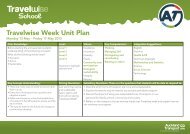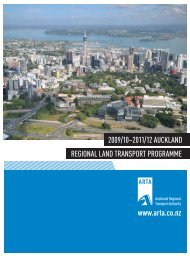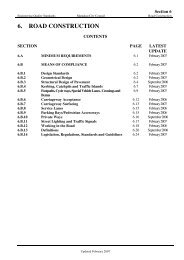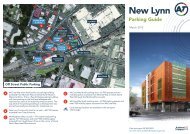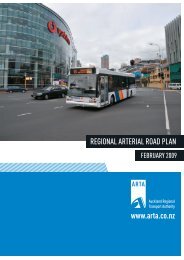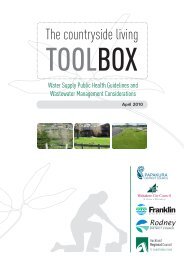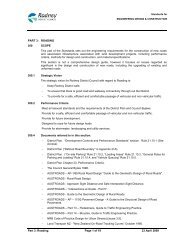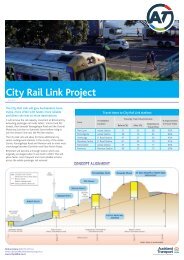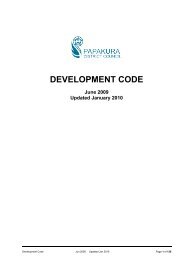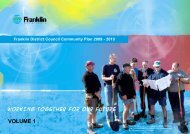Auckland Transport Statement of Intent 2012 - 2015
Auckland Transport Statement of Intent 2012 - 2015
Auckland Transport Statement of Intent 2012 - 2015
You also want an ePaper? Increase the reach of your titles
YUMPU automatically turns print PDFs into web optimized ePapers that Google loves.
Property, plant and equipment acquired after transition<br />
Property, plant and equipment acquired after transition are initially shown at cost or at fair value in the<br />
case where an asset is acquired at no cost, or for a nominal cost. Cost includes any costs that are<br />
directly attributable to the acquisition <strong>of</strong> the items.<br />
Subsequent costs<br />
Subsequent costs are included in the asset‟s carrying amount, or recognised as a separate asset, when<br />
it is likely future economic benefits associated with the item will flow to <strong>Auckland</strong> <strong>Transport</strong>, and the cost<br />
<strong>of</strong> the item can be measured reliably. All other repairs and maintenance are charged to the statement <strong>of</strong><br />
comprehensive income for the financial period they relate to.<br />
Valuation <strong>of</strong> assets<br />
<strong>Auckland</strong> <strong>Transport</strong> accounts for revaluations on a class <strong>of</strong> assets basis.<br />
The revaluation for roading infrastructure and rolling stock was completed last financial year. The<br />
roading infrastructure revaluation was done internally with the support <strong>of</strong> specialist expertise while the<br />
revaluation for rolling stock was completed by an independent expert. Both revaluations have used the<br />
depreciated replacement cost method, to ensure that their carrying amount does not differ materially from<br />
fair value. Roading infrastructure is revalued at least once every three years.<br />
The revaluation for operational land and buildings for the current year will be completed by an<br />
independent expert.<br />
Any accumulated depreciation at the date <strong>of</strong> revaluation is transferred to the gross carrying amount <strong>of</strong> the<br />
asset, and the asset cost is restated to the revalued amount.<br />
Increases in asset carrying amounts due to revaluation increase revaluation reserves in equity.<br />
Decreases in asset carrying amounts decrease revaluation reserves in equity only to the extent that the<br />
class <strong>of</strong> assets has sufficient revaluation reserves to absorb the reduction. All other decreases are<br />
charged to the statement <strong>of</strong> comprehensive income.<br />
If a revaluation increase reverses a decrease previously recognised in the statement <strong>of</strong> comprehensive<br />
income, the increase is recognised first in the statement <strong>of</strong> comprehensive income to reverse previous<br />
decreases. Any residual increase is applied to revaluation reserves in equity.<br />
Additions<br />
The cost <strong>of</strong> an item <strong>of</strong> property, plant and equipment is recognised as an asset if, and only if, it is<br />
probable that future economic benefits or service potential associated with the item will flow to <strong>Auckland</strong><br />
<strong>Transport</strong> and the cost <strong>of</strong> the item can be measured reliably. In most instances, an item <strong>of</strong> property, plant<br />
and equipment is recognised at its cost. Where an asset is acquired at no cost, or for a nominal cost, it is<br />
recognised at fair value at the date <strong>of</strong> acquisition.<br />
Disposals<br />
Gains and losses on the sale or disposal <strong>of</strong> assets are determined by comparing the proceeds <strong>of</strong> sale<br />
with the asset‟s carrying amount. Gains and losses are included in the statement <strong>of</strong> comprehensive<br />
income. When a revalued asset is sold or disposed <strong>of</strong>, any amount in the revaluation reserves in equity<br />
relating to that asset is transferred to general equity.<br />
Depreciation<br />
Land (operational) and land-infrastructure are not depreciated. Assets are depreciated on a straight-line<br />
basis. Depreciation writes <strong>of</strong>f the cost <strong>of</strong> the assets to residual value over their useful lives.<br />
33



